Discover how AI is transforming video production for brands. Learn our process for creating high-impact video content that scales your marketing efforts.
In This Article
Subscribe to our newsletter
Video production for brands isn't just about making pretty visuals anymore. It’s a strategic game of creating content that builds awareness, hooks customers, and ultimately, drives business. For years, this meant long, expensive projects, but modern approaches—especially with AI—have completely flipped the script, making the whole process faster, cheaper, and way more scalable.
How AI Is Reshaping Brand Video Production
If your mental picture of video production involves massive film crews, pricey studio rentals, and production timelines that drag on for months, it’s time for an update. The world of brand video is in the middle of a massive shift, and artificial intelligence is at the wheel.
This isn't just about shaving a few dollars off the budget. It's about giving marketing teams the power to move with incredible speed, unlock new creative possibilities, and make smarter, more precise decisions.
Traditionally, even a single high-quality brand video was a heavy lift, demanding a huge investment and a ton of coordination. But now, brands are ditching those slow, monolithic projects for nimbler, AI-driven systems. This new way of working opens up opportunities that were once completely out of reach for most companies.
The New Creative Workflow
The ripple effect of AI is felt across the entire production process. It lets you rapidly test different messages, visuals, and calls to action without ever needing to schedule a reshoot. Imagine creating dozens of variations of a single ad concept to see exactly what clicks with different audience segments. Suddenly, personalization isn't a luxury; it's a scalable reality.
AI-powered workflows also mean that your creative decisions can be backed by solid data. Instead of just going with your gut, you can analyze performance metrics in real time and tweak your content strategy on the fly. This creates a powerful feedback loop that constantly refines and improves every video you put out.
The real game-changer here is the move away from resource-heavy, one-off projects to a continuous, data-informed content engine. It's democratizing high-quality video, putting it in the hands of brands of all sizes.
Before we go further, it's helpful to see just how different these two worlds are.
Traditional vs AI-Powered Video Production
This table breaks down the key differences between the old way of doing things and the new AI-driven approach.
| Aspect | Traditional Production | AI-Powered Production |
|---|---|---|
| Process | Linear, siloed stages (pre-production, production, post-production). | Integrated, iterative workflow. |
| Cost | High fixed costs (crew, equipment, locations, talent). | Lower variable costs, often subscription-based. |
| Speed | Weeks or months from concept to final video. | Hours or days for initial versions and variations. |
| Scalability | Difficult and expensive to scale or create variations. | Easy to generate numerous variations for different platforms and audiences. |
| Revisions | Time-consuming and costly, often requiring reshoots. | Fast and affordable, with AI handling most of the changes. |
| Data Use | Limited to post-campaign analysis. | Real-time data integration for continuous optimization. |
As you can see, the shift isn’t just incremental; it’s a complete overhaul of the creative process, prioritizing agility and intelligence.
Why This Matters for Marketers
This evolution isn’t happening in a vacuum. Video has become an absolute necessity in modern marketing. By 2025, it’s expected that around 89% of businesses will be using video as a core marketing tool. On top of that, a whopping 96% of marketers say video has directly helped them increase brand awareness. These aren't just vanity metrics; they prove that video is a critical engine for customer engagement and growth.
At the end of the day, AI isn’t here to replace creative ideas or strategic thinking. What it is doing is tearing down the technical and financial walls that used to hold brands back.
The result? Better videos, faster production cycles, and smarter marketing all around. If you want to dive deeper, you can learn more about how AI is transforming video quality in our detailed guide on enhancing and restoring footage.
Building Your AI-Powered Video Strategy
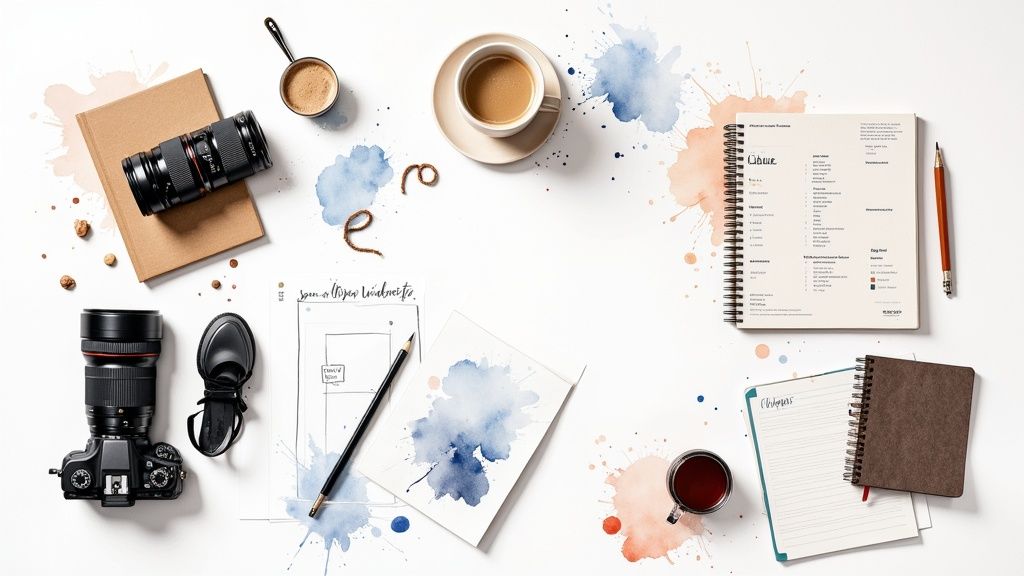
Before you generate a single frame of video, the most important work needs to happen: building a rock-solid plan. I've seen too many brands jump into video production chasing the latest trend, only to end up with flashy content that doesn't move the needle.
Effective video isn't about just making noise; it's about creating assets that drive specific, measurable business outcomes. Without a clear strategy, even the most powerful AI tools are just shooting in the dark.
The first thing to do is get ultra-specific with your goals. "More engagement" is a nice thought, but it's not a strategy. What does success actually look like for you? Are you trying to bump up landing page conversions by 15%? Maybe you want to slash customer support tickets with better how-to videos, or generate more qualified leads from your social campaigns. Each of these goals demands a totally different kind of video.
Once you know why you're making videos, you can start mapping specific concepts to each stage of the customer journey. This simple step ensures every piece of content has a job to do, guiding viewers from that first "hello" all the way to becoming a loyal customer.
Matching Video Content to the Customer Journey
Mapping content isn't just some textbook exercise; it's a practical way to keep your production efforts focused and efficient. Think about it: a potential customer who has never heard of your brand needs something completely different from a long-time fan.
Here’s a simple way I like to break it down:
- Awareness Stage: This is your first impression. Short, snappy social media clips and brand story videos are perfect here. They’re designed to grab attention and introduce your brand's personality without a heavy sales pitch.
- Consideration Stage: Now it's time to build trust. This is where you bring out the detailed product demos, authentic customer testimonials, and in-depth case study videos. You're giving prospects the proof they need to feel confident in their choice.
- Decision Stage: To get them over the finish line, you need content that seals the deal. Think personalized sales videos, helpful FAQ explainers, or even side-by-side comparison videos that clearly show why you're the better option.
Approaching your content this way means your AI-powered production is always purposeful. Instead of just brainstorming random ideas, you’re systematically building a library of assets designed to make an impact at every single touchpoint. For a deeper dive into this process, you can check out https://project-aeon.com/blogs/your-guide-to-branding-video-production.
Brainstorming for AI-Driven Production
With your strategic map in hand, you can finally start brainstorming ideas that truly play to AI’s strengths. This is where things get really exciting, especially when it comes to scale and personalization.
Imagine generating dozens of ad variations with different hooks and visuals to A/B test in a single afternoon. Or creating hyper-personalized onboarding videos for new customers where names and company details are swapped out automatically. This is the kind of stuff that used to take a whole team weeks to pull off.
A fundamental step in building any effective video strategy, including one powered by AI, is to thoroughly plan your content; learn how to master your video brief template to align your vision and goals.
This level of detailed planning is more critical than ever. We know that roughly 91.8% of internet users watch videos every week, and video makes up an estimated 82% of all internet traffic. That’s an incredibly crowded space.
And with around 75% of that viewing happening on mobile devices, your content has to be concise and impactful enough to stop the scroll. A solid strategic foundation is what ensures every AI-generated video you create has a clear purpose and a direct path to delivering real results.
So, you want to see what this actually looks like in practice? Let's walk through the entire AI-powered video production for brands workflow from start to finish.
To make this real, let's say you're a marketing manager at a SaaS company. Your next big task is to create a punchy promotional video for a brand-new app feature.
The old way? Weeks of planning, hiring a production crew, and trying to align everyone's schedules for a shoot. The new way? We’re going to build this entire video in a fraction of the time with a modern, AI-first approach. It all starts with the creative spark, but now, AI is your co-pilot.
This graphic really breaks down how AI can supercharge those initial creative stages.
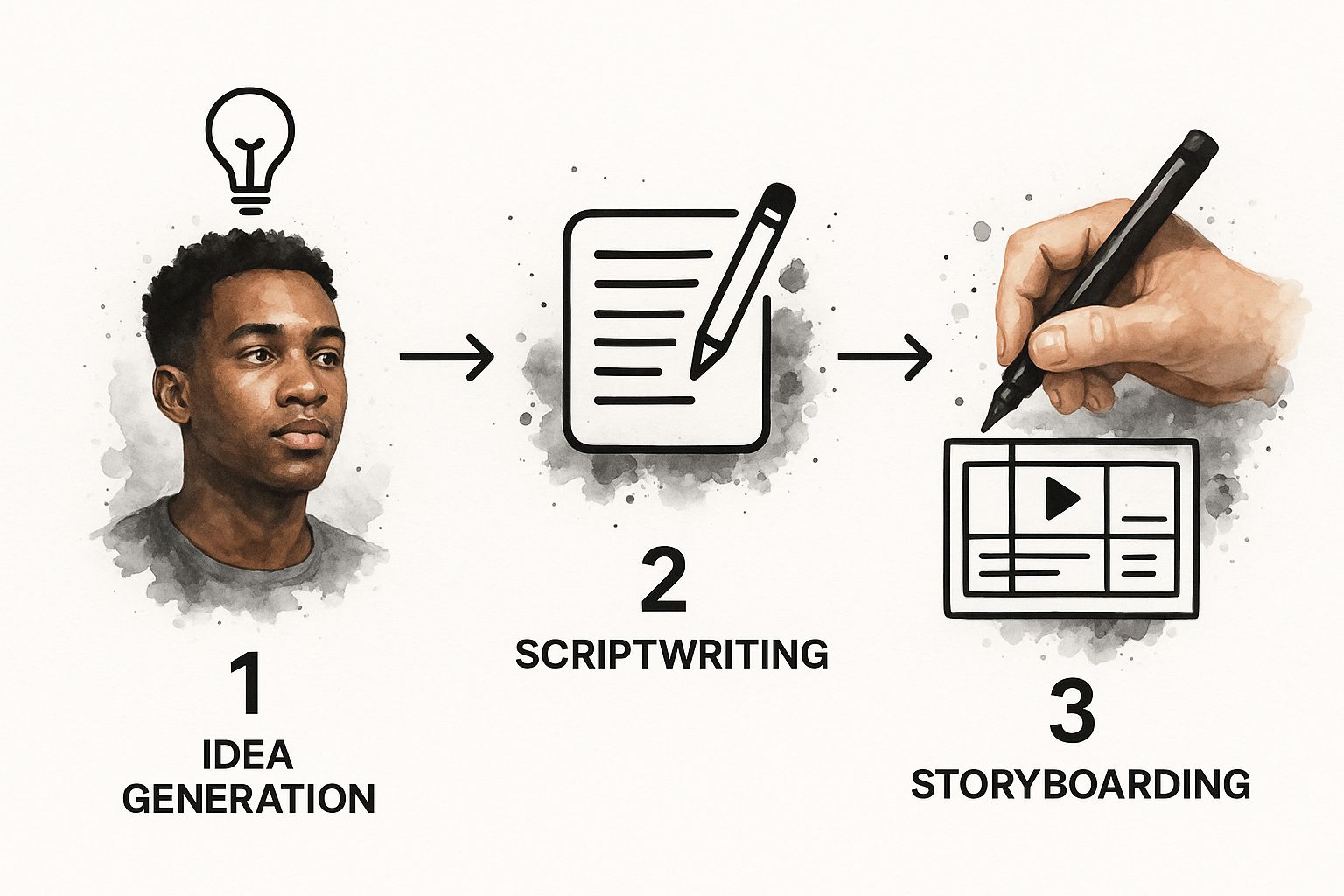
What used to be a long, drawn-out pre-production phase gets collapsed into a few focused sessions. You can move from a simple idea to a full-blown visual plan faster than ever.
From Prompt to Polished Script
Instead of battling a blank page, you kick things off with a simple prompt for an AI scriptwriter. Something like this:
"Write a 60-second video script for a new feature called 'Instant Analytics' in our project management app. The tone should be upbeat and focused on saving users time."
In just a few minutes, you'll have several script variations to choose from. Pick your favorite, tweak a few lines to perfectly match your brand's voice, and you're done. This single step can honestly save hours—if not days—of brainstorming and writing.
With your script locked in, it's time to give it a voice. Forget about booking studio time or sifting through voice actor demos. AI voice generation platforms let you just paste your script, pick a voice style—maybe professional and clear, or something more friendly and conversational—and generate a high-quality audio file on the spot.
Generating Visuals with AI Avatars
Now for the visuals. This is where tools that create AI avatars and generate video from text are complete game-changers. You can pick from a library of stock avatars or even create a custom one that looks like someone on your own team for a more personal touch.
The process is incredibly straightforward. You pair your script with an avatar, place them against a clean background, and let the platform work its magic.

There's no camera required. Just upload your AI-generated voiceover, and the platform animates the avatar to deliver the script with surprisingly realistic lip-syncing. The result is a polished, professional-looking presenter without any of the traditional production headaches.
This workflow isn't just about speed; it's about agility. Need to update a feature name or change a call-to-action a month later? Simply edit the text and re-render the video in minutes. No reshoots, no extra budget required.
Assembling the Final Video
The last piece of the puzzle is bringing everything together. A good AI video editor can take your avatar footage and automatically find relevant B-roll clips based on keywords from your script—think "analytics," "charts," or "team collaboration."
It doesn't stop there. The tool will also find a fitting, royalty-free music track and sync all the elements together into a cohesive final cut.
This whole process is a fantastic example of effective https://project-aeon.com/blogs/media-workflow-automation-boost-production-efficiency, which is all about cutting down on manual work and boosting efficiency. For a much deeper dive on this part of the process, a good AI video editing guide can show you how to get the most out of these powerful tools.
What you're left with is a professional, engaging video for your new app feature, all created without the massive overhead of a traditional shoot. This is the new standard for agile, scalable video production for brands.
Choosing the Right AI Video Tools
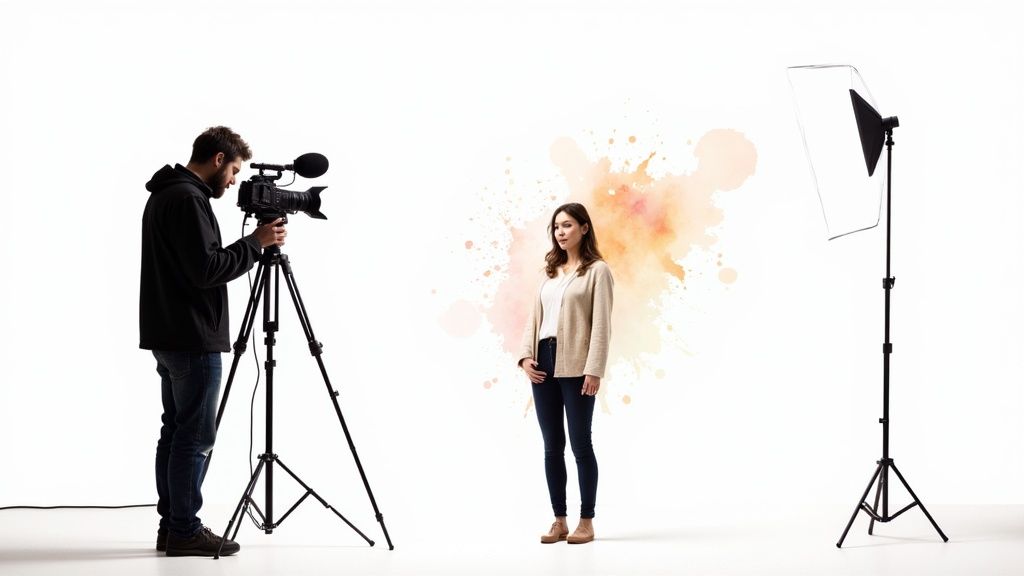
Diving into the world of AI video tools can feel like a lot. New platforms pop up constantly, and it’s genuinely tough to tell which ones actually deliver on their promises for professional video production for brands.
The trick is to stop looking for a single magic tool that does everything. Instead, think of it like building a specialized crew. You need a stack of essential tools where each one plays a specific, distinct role in your workflow.
This approach gives you way more control and, frankly, better results. You get to pick the best-in-class option for each part of the job.
For most brands I’ve worked with, a solid AI video toolkit really comes down to four core categories. Get these right, and you’ll be able to manage the whole process—from a rough idea to a polished final video—with incredible speed.
Core AI Tool Categories for Brands
The modern video creator’s toolkit is a mix of specialized AI assistants. Each one is designed to tackle a different, time-sucking part of the traditional production process, automating tasks that used to require hours of manual work or expensive outside help.
Here are the main categories you should be looking at:
- AI Scriptwriters: This is your starting block. These tools can take a simple prompt or a detailed outline and spit out a structured, engaging script in minutes. They’re fantastic for breaking through writer’s block and exploring different angles for a story.
- Text-to-Video Generators: Here’s where your words become visuals. Platforms like Synthesia or InVideo take your text and automatically pull in relevant stock footage, add subtitles, generate voiceovers, and sync music to create a solid first draft.
- AI-Assisted Video Editors: Think of these as your super-smart editing assistants. They can automatically find the best takes in your raw footage, chop out awkward silences, clean up audio, and even create highlight reels from longer videos. It’s a game-changer for post-production time.
- Voice and Avatar Creators: These tools let you skip the need for traditional voice actors or on-camera talent. You can generate incredibly realistic voiceovers in almost any language or style, and even create custom digital avatars to present your content. This is huge for maintaining brand consistency.
The real goal here isn’t to replace human creativity—it’s to supercharge it. By letting AI handle the repetitive, technical grunt work, your team is free to focus on the high-level strategy and storytelling that actually makes your brand stand out.
With so many AI video tools out there, it helps to see how they fit into a typical brand marketing workflow. Each category serves a unique purpose, from initial concept to final polished asset.
Top AI Video Tool Categories and Uses
| Tool Category | Primary Function | Best For |
|---|---|---|
| AI Scriptwriters | Generates video scripts from text prompts. | Kicking off the creative process, brainstorming multiple video concepts quickly, and overcoming writer's block. |
| Text-to-Video Generators | Converts text scripts into full videos with stock footage, voiceover, and music. | Creating social media clips, short-form explainers, and content marketing videos at scale with minimal effort. |
| AI-Assisted Video Editors | Automates tedious editing tasks like cutting, audio enhancement, and color correction. | Editing talking-head videos, podcasts, and long-form content like webinars or product tutorials much faster. |
| Voice & Avatar Creators | Generates realistic synthetic voiceovers and custom digital human presenters. | Corporate training videos, multilingual content, and creating a consistent brand presenter without a human actor. |
This table should give you a clearer picture of where each type of tool fits. You likely won't need just one; a combination is usually the most powerful approach.
How to Select the Right Tools for Your Needs
Okay, so how do you actually choose from the sea of options? Your decision should really boil down to a few key factors that are unique to your brand’s situation.
First, nail down your primary use case. Are you trying to pump out dozens of short, snappy clips for TikTok and Reels? If so, a text-to-video generator with great social media templates is your best bet. On the other hand, if you're producing in-depth product tutorials, you’ll want an AI-assisted editor that can handle longer-form content gracefully.
Next, you have to seriously evaluate the quality of the output. Don’t just trust the marketing site. Get demos and run your own trials. Pay close attention to how natural the AI voices sound, how relevant the B-roll footage is, and the overall polish of the final video. A tool that looks great on paper but produces robotic or generic content can do more harm than good for your brand.
Finally, think about scalability and cost. Some tools are perfect for a solo creator on a tight budget and offer affordable monthly plans. Others, like Descript, are built for enterprise teams with features for collaboration and brand asset management, but they come with a higher price tag. Pick something that fits where you are now but gives you room to grow as your video strategy gets bigger.
Getting Your AI Videos Seen: Distribution and Optimization
Making a great video with AI is a huge first step, but it's really just the beginning. What's the point of a brilliant video if no one in your target audience ever lays eyes on it? This is where a smart distribution and optimization plan comes in, turning that creative asset into a real performance driver for your brand.
The magic of an AI-powered workflow goes way beyond just the initial creation. You can take one core video and instantly spin it up into a dozen different formats, each one perfectly cut for the platform it’s going on.
That means your polished YouTube explainer can become a series of snappy TikToks, a professional LinkedIn post, and a handful of engaging Instagram Reels in a matter of minutes, not days. This approach blows up your reach without blowing up your workload.
Ditching Vanity Metrics for Real Insights
Once your videos are out in the world, you need to figure out what’s actually working. Traditional analytics often give you surface-level numbers like views and likes, which feel good but don't tell you the why.
Modern AI analytics tools, on the other hand, can dig much, much deeper. They can give you a second-by-second breakdown of how people are actually engaging with your content. You can pinpoint the exact moment viewers lose interest and drop off, see which parts they’re rewatching, and figure out what visual or story hooks are grabbing their attention.
This data is your secret weapon. It stops you from just guessing what to do next. Instead, you get a clear, data-driven feedback loop to constantly make your video production for brands better and better.
This cycle of continuous improvement is how you maximize your return. The proof is in the numbers, and they're pretty staggering. By 2025, a massive 93% of marketers are seeing a positive ROI from video. It’s backed by real results, too: 90% say video helped them generate more leads, and 87% confirmed it directly boosted sales. You can dig into even more of these powerful video marketing statistics to see the full picture.
Building a System for Constant Improvement
When you're armed with this level of detail, you can make small changes that have a big impact.
For instance, if you notice a huge drop-off 10 seconds into your product demo, you know your intro isn’t landing. With that insight, you can use AI to quickly generate and test a few new hooks to see which one keeps people watching.
This iterative process ensures your video content gets smarter and more effective over time. Here’s a simple system to put this into practice:
- Deploy and Monitor: Get your repurposed video clips live across all your channels.
- Analyze Engagement Data: Use AI analytics to track drop-off points, re-watch peaks, and click-through rates.
- Spot the Weak Points: Is the call-to-action buried? Is the middle section dragging?
- Tweak and Redeploy: Jump back into your AI editor, adjust the script, visuals, or pacing, and launch the new version.
This agile approach lets you react to what your audience is telling you almost in real-time. It’s how you make sure your investment in video production consistently delivers measurable results for your brand.
Still Have Questions About AI Video Production?
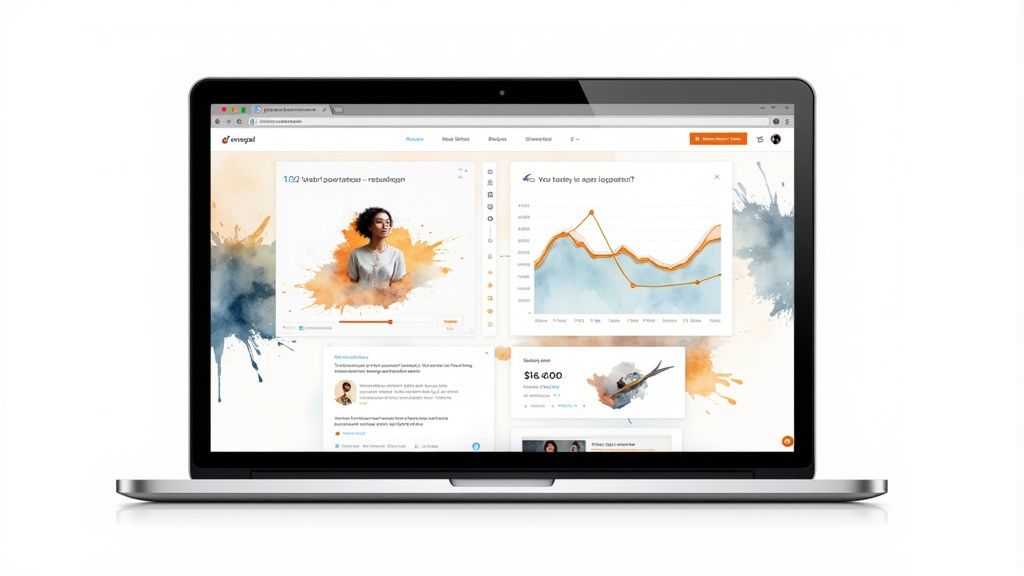
It’s totally normal to approach video production for brands using AI with a bit of skepticism. When a new technology promises to overhaul your entire workflow, asking tough questions isn't just smart—it's necessary.
Let's cut through the noise and tackle the most common concerns we hear from brands who are just starting to dip their toes into AI-driven video.
Will AI-Generated Videos Actually Look Professional?
This is probably the number one question on everyone's mind. There's a real fear that "AI-generated" is just a fancy term for robotic, cheap-looking content. While that might have been true for some of the early tools, the technology has come a long way, very quickly.
Today's top-tier platforms can deliver videos with crisp visuals, seamless editing, and voiceovers that sound surprisingly human. The trick is to use these tools as a creative partner, not a total replacement for your team's expertise. A well-crafted AI video can easily hold its own against a traditionally produced corporate video, especially for things like social media clips, internal training modules, or product explainers.
The secret to professional-looking AI video isn't about letting the machine do everything. It’s about letting AI handle 80% of the grunt work, so your team can pour their energy into creative strategy, script polishing, and adding those final human touches.
Isn't AI Video Super Expensive?
The term "artificial intelligence" often sounds like it comes with a hefty price tag. But honestly, one of the biggest reasons brands are flocking to AI for video is because it’s so much more cost-effective. A traditional video shoot can easily balloon into tens of thousands of dollars before you know it.
AI video tools flip that model on its head. Most operate on a simple subscription basis, with plans often starting for less than a hundred bucks a month. You can create dozens of videos for a fraction of what a single professional shoot would cost. It completely lowers the barrier to entry, making consistent video marketing a reality even for brands on a tight budget.
Think about what you're not paying for:
- Location fees: No need for expensive location scouting when you have virtual sets and endless stock footage.
- Talent costs: AI avatars and high-quality voiceovers mean you don't have to hire actors for every single project.
- A massive crew: One or two people can manage the entire production process, not a whole film crew.
What's the Deal with Copyright and Usage Rights?
This is a big one. You need to know who owns the final video and whether you can actually use it for your business. It all comes down to the terms of service for the tool you're using, so make sure you read them.
Most reputable platforms are straightforward about this. When you create a video on their platform, you own the final product. You can use it commercially however you see fit. The stock footage, music, and other assets they provide are licensed for you to use in your creations. The only catch is that if you upload your own assets—like your logo or specific product shots—you're responsible for making sure you have the rights to use them.
Always double-check the specifics with any provider you choose. It’s a simple step that can save you a lot of headaches down the road.
Ready to see how AI can reshape your content strategy? At Aeon, we've built a powerful platform to help you create high-quality, on-brand videos at scale. Schedule a demo with us today and find out how you can automate your video workflow and start driving better results.
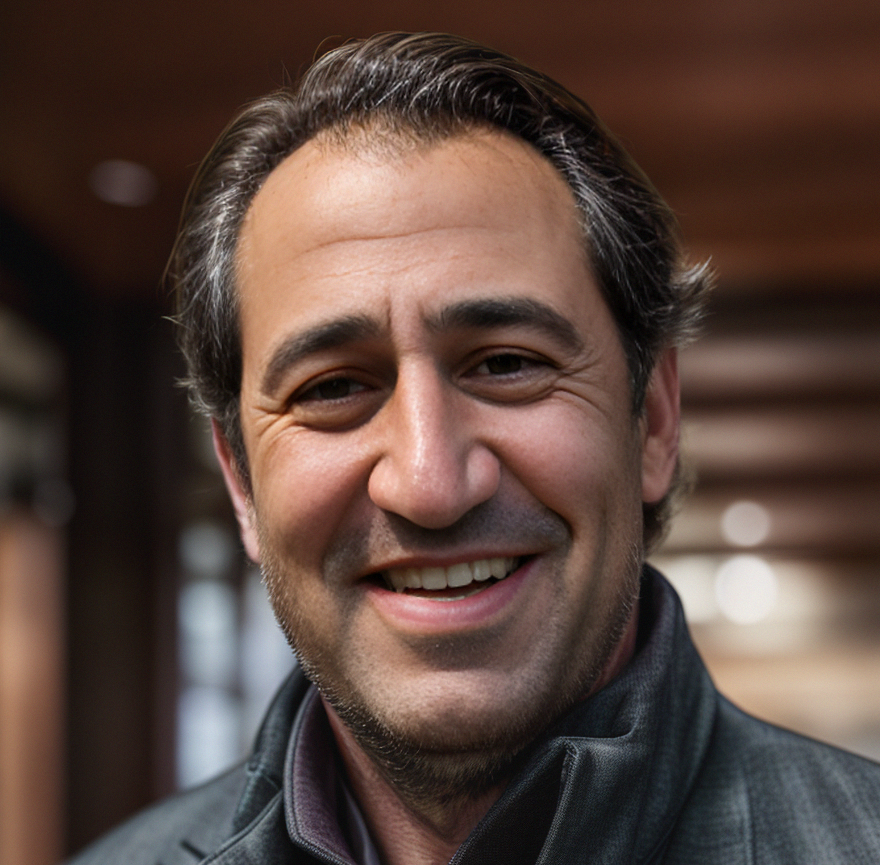
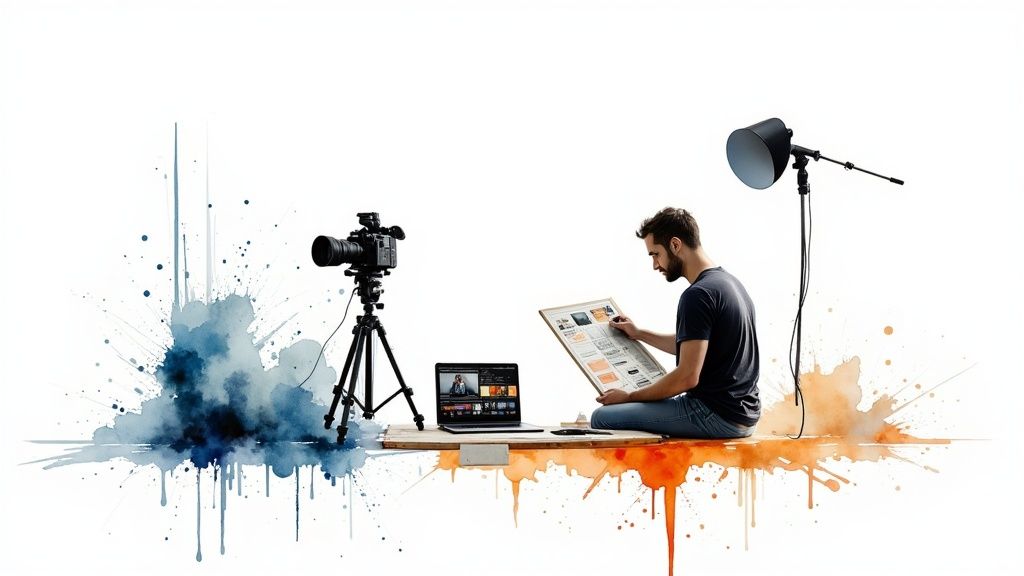
.jpg)